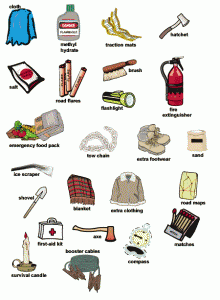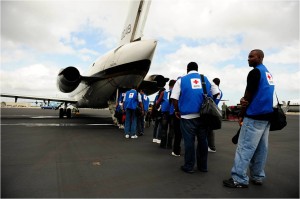Brain storming Ideas:
As a group we have brainstormed many ideas for a possible emergency preparedness kit for our client. Our main topics of concern were the accessibility and contents of the kit. After visiting Eric’s home we have thought of a few places where the kit can be placed and could be easily accessible. As for the contents inside the kit, we have come up with many items which are a necessity in case of an emergency. These items are: water, flashlight, blanket, whistle, glow stick, first aid kit, dust mask, and granola bars.
We have brainstormed many different ideas for the accessibility and content of the kit. Some of these ideas have been great while others have been implausible. The technique our team has used to rule out some of these implausible ideas are by taking a vote amongst the team and doing some research online on things we weren’t sure about. For instance one group member suggested we needed six liters of water in the kit. As none of us was sure how much water a human needs to survive, one of our group members did research and discovered it is more probable to have two liters of water in the kit.
We have recently just finalized many aspects of our kit and its contents. It was not easy to finalize some of the items in the kit since our group had came up with many great ideas but we still needed to keep within our budget so some decisions had to be made. Ultimately we decided to take out some of the less necessary things for survival. As for the kit itself, we decided to go with a soft kit instead of a hard kit as it would be more easily accessible to our client and also it wouldn’t break if it fell on the ground. We have also chosen to go with bottled water with a squeeze cap as our client is only able with one arm and cannot open a twisting cap. For the location of the kit in Eric’s home we have narrowed it down to somewhere in his kitchen or bedroom. This would be an ideal place to put the kit because this is where he will be mostly at his house. Another choice we have made is to keep the kit some place of arms length away so he can easily access it. We immediately ruled out putting it somewhere on the ground as it word be hard for him to access it during an emergency.
Overview:
On Feb 1, our group met with Eric, our client. Some of the important highlights from the meeting were:
**The budget for the kit is 50-100$
**Soft cover kits are more preferable
**Eric take only multi-vitamins and cold-fx
**The kit is better not to be attached to Eric’s chair
Next, we researched on some of the contents and convenient sizes for the emergency kit. An appropriate size bag was found that could fit in all the necessary contents. After finding the kit,3 important issues were reviewed:
The amount and type of water placed in the kit so that it will fit and also not go bad, the amount of food for three days after an emergency which has to be non-perishable so that it can stay in the kit for some time like granola bars, and the content for our first aid kit, if the content should be hand picked and placed or not.
After 2 weeks on brain storming on Feb 8 we finally agreed on some primary contents for the bag. Thereafter, we had to consider the cost of each item so that it would be in our budget. Although the cost of each item has been considered through out the project decisions, on Feb 15, a rough estimate was made for us to work on. This phase is by far the hardest since it limits us from adding more content if it were needed and also finding the contents so that it would exceed our budget.



